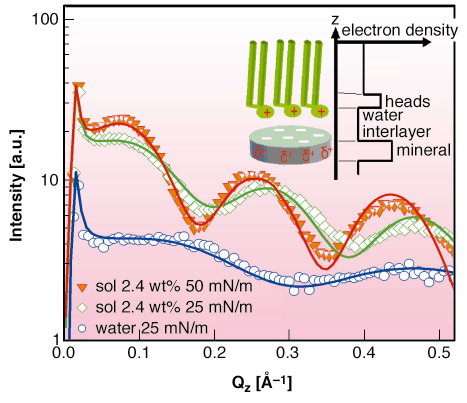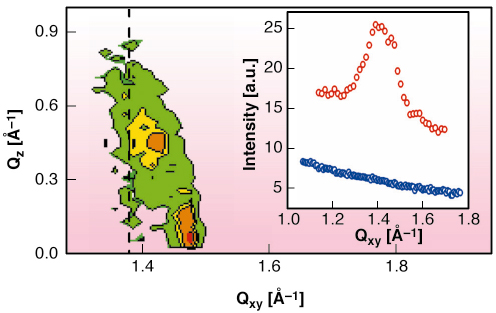- Home
- Users & Science
- Scientific Documentation
- ESRF Highlights
- ESRF Highlights 2005
- Soft Condensed Matter
- Nanocrystal-induced Organisation of a Langmuir Phospholipid Monolayer
Nanocrystal-induced Organisation of a Langmuir Phospholipid Monolayer
A common attribute of quasi-two-dimensional systems like amphiphilic monolayers is liquid crystalline-like behaviour. At the air/water interface, in-plane ordering of such layers is generally limited to a subset of specifically designed molecules. For biomolecules such as phospholipids, the accessibility of an ordered phase depends on the shape and size of the hydrophilic headgroup and length of the hydrophobic alkane chains. Detailed here is the induction of molecular alignment in an inherently non-ordered phospholipid monolayer. This decrease of conformational entropy was achieved by the adsorption of clay nanocrystals underneath the surfactant layer. The initiation of nucleation and growth in such a quasi-two-dimensional organic system leads our thoughts towards the influence of charged surfaces on elastic properties and phase behaviour of organisations such as cellular membranes. Recently molecular dynamics simulations have revealed that surface charge is an important determinant of the inflammatory potential of crystals causing rupture of cellular membranes [1]. As a model system, a combination of the Langmuir technique with X-ray surface diffraction was used to probe the interfacial issues of a lipid membrane in electrostatic interaction with negatively charged nanocrystals.
 |
|
Fig. 64: GIXOS spectra of the membrane with and without minerals. Inset: sketch of the system and model for the electron density profile in the presence of mineral particles. |
The phase behaviour of dimyristoylphosphatidylcholine (DMPC) monolayers was investigated using Langmuir pressure/area isotherms. On aqueous solutions of clay particles (hydrosols) an increase of the collapse pressure of the films was achieved. The slope of the isotherm and the area/molecule indicate a condensed state for surface pressures above 40 mN/m, which are not accessible in the absence of the nanocrystals. The general increase of molecular interactions can be attributed to a reduction of molecular motions within the film undoubtedly induced by the stiffening properties of the adsorbed nanocrystal layer. Grazing Incidence X-ray scattering Out of the Specular plane (GIXOS), a novel technique recently developed at ID10B, was used as a powerful method to investigate the organisation of thin films normal to the liquid surface on the molecular level. The information obtained is equivalent to electron density profiles determined via conventional reflectivity but the time needed for one spectrum is reduced from 1.5 hours to seconds or minutes. This opens up the possibility to investigate dynamic processes [2] or fragile systems, for which the new method was imperative due to the existence of a metastable hydrosol subphase. From the spectra (Figure 64), the tilt angles of the molecules with respect to the surface normal at 25 mN/m were found to be 50° and 42° in the absence and presence of the crystallites, respectively. For 50 mN/m on a sol the tilt angle was found to be reduced to 23°, another indication of an ordered condensed-like phase of the monolayer. No Bragg reflection from the membrane was observed from grazing-incidence diffraction (GID) experiments on a water subphase up to the collapse of the membrane at around 30 mN/m. Conversely, in the vicinity of the crystallites at 50 mN/m, a Bragg reflection was observed that appeared to be richly featured in the reciprocal space map (Figure 65). The contributions due to the alkane chain lattice of the phospholipid monolayer and due to the internal atomic structure of the nanocrystals were resolved by Bragg rod analysis. The Bragg reflections originating from the biomembrane reflect the induction of an ordered phase by electrostatic binding to the nanocrystals.
 |
|
Fig. 65: Reciprocal space map of the Bragg reflection of the ordered membrane at 50 mN/m. The mineral distribution (along the dashed line) could be separated by Bragg rod analysis. Inset: in-plane Bragg peaks at a surface pressure of 50 mN/m in the vicinity of minerals (red symbols) and at 30 mN/m on pure water (blue symbols). |
In conclusion we have overcome the issue of weak interaction between individual molecules of an inherently nonordered phospholipid monolayer and induced a phase shift towards an ordered phase. This effect is caused by the stiffening properties of the crystals and the anchoring of individual molecules to the charged surfaces of the nanocrystal templates.
References
[1] A. Wierzbicki, P. Dalal, J. D. Madura, H. S. Cheung, J. Phys. Chem. B, 107, 12346-12351 (2003).
[2] L. Wiegart, S. M. O'Flaherty, P. Terech, B. Struth, Soft Matter, 2, 54-56 (2006).
Principal Publication and Authors
L. Wiegart (a,b), S.M. O'Flaherty (a), B. Struth (a), Langmuir, 21, 1695-1698 (2005).
(a) ESRF
(b) CEA-CNRS-Université J. Fourier



